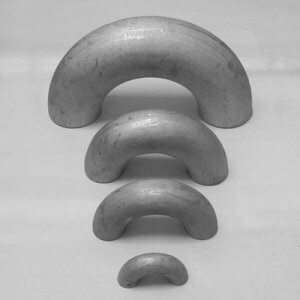
An elbow is a pipe connection often used to change the flow direction of a pipe. Bend pipes can be made of different materials, such as carbon steel, stainless steel, alloy steel, copper, aluminum, etc. The production of elbows can be achieved by cold bending or hot bending processes, and the size of the elbow is usually determined based on the outer diameter and bending radius of the pipe. Bend pipes can be divided into two types: straight bends and elbows. Elbows usually refer to bends with specific angles, such as 45 degrees, 90 degrees or 180 degrees. Bend pipes are widely used in petroleum, chemical, aviation, shipbuilding, nuclear power and other industries.
1. Bend pipes are divided by material:
Carbon steel: ASTM/ASME A234 WPB, WPC
Alloy: ASTM/ASME A234 WP 1-WP 12-WP 11-WP 22-WP 5-WP 91-WP911, 15Mo3 15CrMoV, 35CrMoV
Stainless steel: ASTM/ASME A403 WP 304-304L-304H-304LN-304N
ASTM/ASME A403 WP 316-316L-316H-316LN-316N-316Ti
ASTM/ASME A403 WP 321-321H ASTM/ASME A403 WP 347-347H
Low temperature steel: ASTM/ASME A402 WPL3-WPL 6
High performance steel: ASTM/ASME A860 WPHY 42-46-52-60-65-70
Cast steel, alloy steel, stainless steel, copper, aluminum alloy, plastic, vinyl, PVC, PPR, RFPP (reinforced polypropylene), etc.
Aluminum alloy 3003, 6061, copper, copper, brass
2. According to the production method, it can be divided into pushing, pressing, forging, casting, etc.
Contact
- Tel:+86 317 6019016
- Contact person:Mr. Dai
- Wechat:13102449099
- Mobile:+86 1310 244 9099
- E-mail:18713768122@163.com


